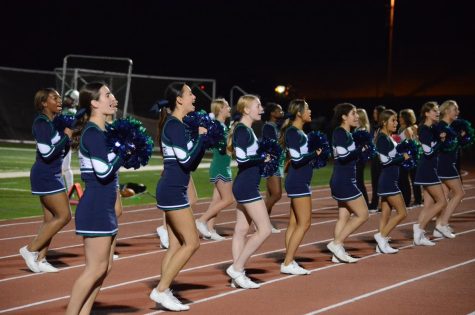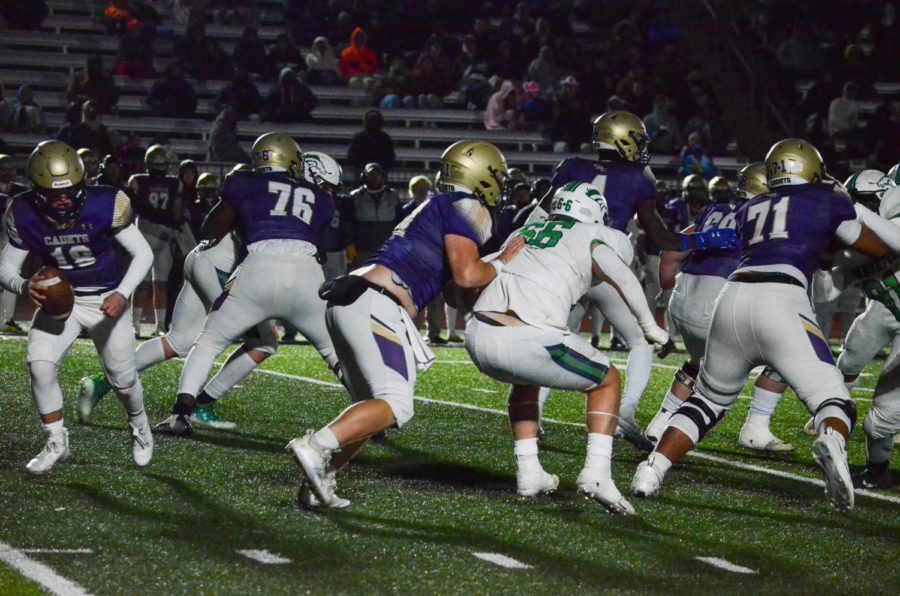As a flyer on the varsity cheerleading team, Ashley Schaller, senior, said she has to be fearless.
Her role involves being thrown up into the air as high as possible by the cheerleaders at the base of the routine. However, with being in the air comes the possibility of falling as well, and Schaller has sustained numerous injuries from falling.
“I’m starting to realize how dangerous it can be,” Schaller said. “I love cheer. I’ve done it my whole life, but I have to live with my brain my whole life.”
In under 18 months, Schaller has sustained three concussions — the first in August of last year, the second at the end of last November and the most recent on Monday, Sept. 19.
Schaller is not alone. According to an ongoing 13-year study conducted by the American Academy of Orthopaedic Surgeons, incidences of concussions across all sports have increased despite greater awareness about the injury.
Ten percent of all contact sport athletes sustain concussions yearly, according to the Brain Injury Research Institute. Contact sports include sports such as football and soccer along with cheerleading.
Dr. Jonathan Tiu, assistant professor of neurology and orthopedic surgery at Washington University, specializes in neurorehabilitation. He defines a concussion as any physical change to the brain, either from direct impact or whiplash, that prevents normal function of the brain.

Dr. Tiu said neurological symptoms of concussions consist of headaches, dizziness and imbalance. People may also have trouble focusing and may feel more irritable and anxious. A concussion injury may also affect sleep.
“There is some thought that concussions can disrupt the normal function of our emotional circuits in our brain,” Dr. Tiu said. “It’s quite difficult to isolate these emotional circuits because of how complex human behavior is.”
Dr. Tui said other more objective measures such as cognitive tests and tests of balance and eye function can help to evaluate a concussion’s impact on an athlete as well.
Long-term effects of concussions and head injuries are still being researched, but potential implications could include an effect on cognition. However, Dr. Tui said he sees less permanent damage to the brain from a concussion than other brain injuries.
“The majority of people who have had a concussion will report that at least in terms of how they feel, their symptoms will completely resolve within a week or so,” Dr. Tui said.
EFFECT ON STUDENTS
Schaller said her condition from her most recent concussion made her unable to compete in this year’s Regionals and Qualifiers, and she will most likely be unable to compete at State as well. She has taken a break from cheerleading for more than a month.
Schaller said she also has trouble concentrating in classes and suffers from sporadic headaches. This discomfort impacts her ability to focus in class and often forces her to leave school because of the pain.

Teachers provide her with paper notes as opposed to online copies to limit her screen exposure.
She said her pediatrician warned her against continuing flying in the future and has even recommended her taking a longer break from the sport.
Kevin Schaller, Ashley’s father, said an injury such as a concussion can be detrimental to an individual’s day-to-day life.
“I get it, sports are sports and people are competing extremely hard, so injuries can occur,” Kevin said.
The medical professionals he brought his daughter to was three concussions was a lot, Kevin said.
“I take a step back and think I love her so much that if something were to happen, I couldn’t forgive myself,” Kevin said. “She has her entire life ahead of her.”
Sophomore Donovan Fitzmaurice, defensive tackle for the varsity football team, sustained a concussion in the football game against Pattonville on Oct. 21.
“I was dizzy, but I just kept going,” Fitzmaurice said. “I just knew I had one.”
Fitzmaurice has had to change his everyday routine as a result of his injury.
“I just limit so much activity, take things slow,” Fitzmaurice said. “And just take care of my body.”
But Fitzmaurice said he isn’t worried about concussions in the future, and neither is junior Brianna Kappeler, varsity soccer defender.
“There’s always the worry that when you’re going to go up for a head ball against someone else that you’re going to hit heads and could get a concussion,” Kappeler said. “There’s always the possibility. You never really know with head injuries and there’s nothing you can really do to prevent it.”
CURRENT MEASURES
Michael Stewart, football coach, said every coach is trained in identifying concussions through symptomatic tests. If a player is thought to have a concussion, they are passed on to MHS’ athletic trainer, Jessi Austin.
Austin then assesses the details of the injury and performs more precise tests on balance, memory and cognition, such as SCAT-5 and Bombs tests on the player. If the tests conclude the player has a concussion, they are sent to a neurologist and will recover on average for 7 to 10 days until symptoms subside. The recovery process involves limiting strenuous activity and excessive screen time to be safe.
Austin said she has seen between 10 to 15 concussions since the beginning of this year.
“I’ve seen some people get better in two days,” Austin said. “I’ve seen some people take months.”
Ashley Hobbs, j.v. cheer coach, said the number one priority in cheerleading is safety, and the first thing all athletes are taught is how to be safe.
“By nature we are lifting people in the air, throwing people in the air, catching people in the air,” Hobbs said. “That means you have to protect those people, not just in the air, but on the ground.”
The first practice always starts with the most basic cheerleading skills and progressively gets more advanced. If one of the cheerleaders cannot handle a skill, they do not move on, Hobbs said.
Besides training athletes, coaches also use technology to safeguard athletes. For example, in football they use form-fitting helmets and are exploring other new technologies like a Q-Collar.
Stewart said the theory of the Q-collar is that it is placed around a player’s neck and applies pressure to the neck, pooling up blood in the brain to pad it more. Q-collar prevents the brain from bouncing around inside the skull and hitting the sides.
Although Q-Collar isn’t available for high school students yet, eventually if it works well enough it will trickle down to the lower levels, Stewart said.
Carol DeMatteo, professor of rehabilitation science at McMaster University, said Q-collars are not scientifically proven to improve conditions and form-fitted helmets can’t stop a brain from moving within the skull.
DeMatteo said even though the technology doesn’t completely work, other strides in sports safety have been made, such as changing the rules around rougher play and hits to the head to prevent these injuries.
After a player’s first concussion they are prone to more.
“50 percent of youth will have another injury within one year of the first,” DeMatteo said.
This story was originally published on Marquette Messenger on December 7, 2022.




































